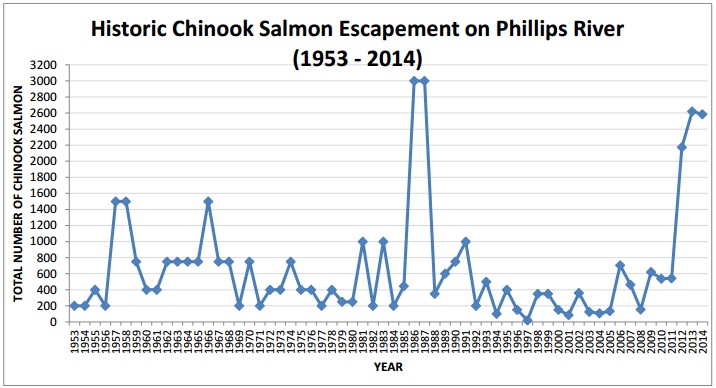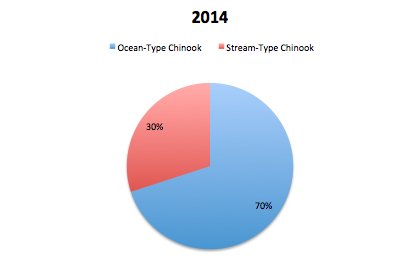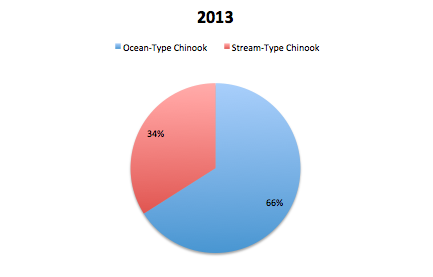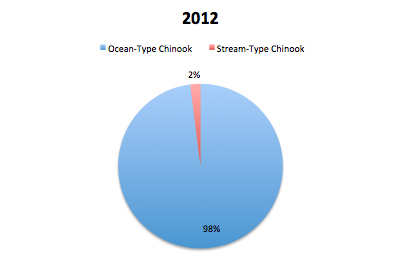A metric that can be used to evaluate the efforts of the GPFA is the number of adult Chinook that have returned to mate in the Phillips River. Gillard Pass identifies that the Phillips River watershed has a capacity of 2500 mating adults that would provide a stable and self sustaining amount of chinooks. The S1 chinooks that GPFA have released into the wild have been returning as of 2011. In 2012, Gillard Pass estimated that over 2300 adult chinooks returned to mate; this was the largest return seen since the 1980s. In 2013, over 2700 adult chinook returned and in 2014, about 1800 adult chinooks returned to the Phillips. Though the 2013 return surpassed this ‘sustainable capacity’ goal, one will only be able to consider the chinook population in the Phillips River recovered when this number of spawners has reached the goal consistently over several years.

The increasing trend in the Phillips river chinook population since 2012. (Anderson and McCorquodale 2015)
GPFA also hopes to contribute to the strength of the chinook population in the Phillips by restoring the diversity of types of chinooks in the river system. The stream-type chinook, who historically were plentiful in the region but were hurt by logging practices, are trying to be increased by the S1 trial. These stream-type chinook coincide with the early chinook mating season which occurs in June. The other type of chinook found in the Phillips is the ocean-type which returns to mate in the late summer and early fall and is much more prevalent in the Phillips river. In order to evaluate the success of the increase in diversity of the chinook population, the ratio of stream-type to ocean-type chinook in the returning spawners is examined. After reviewing returning spawner data in 2013, they found that 66% of the spawners in the Phillips were ocean-type while 34% were stream-type. In 2014, 70% of the spawners were ocean-type while the remaining 30% of spawners were stream-type. Both of these ratios are dramatically different to the data seen in 2012 where 98% of returning spawners were ocean-type and only 2% stream-type. The increase in stream-type chinook to the Phillips River can be attributed to the success of the S1 trial because S1 chinooks are known to have a stream-type life history where typical hatchery fish are known to have an ocean type.
Learn more about stream-type and ocean-type chinook life histories here:

Returning spawners to the Phillips River by life history type in 2014. (GPFA 2015)
The GPFA also wants to ensure that the increased number of spawners returning are the result of an increase in wild chinooks due to hatchery salmon contributing offspring to the wild population. If an increase is purely the result of hatchery salmon, the wild population could be swarmed by hatchery fish, experience a decrease in survival and lose characteristics that make it distinctly suited to the Phillips river. The percentage of wild salmon in the population compared to the percentage of hatchery salmon in the population is used by the Canadian government and GPFA to assess this concern. The aim is to maintain a less than 50% contribution by hatchery fish in any conservation project and less than 30% for long term hatchery projects. Hatchery contributions represented 61% of the Phillips population in 2014, 36.9% in 2013 and 40% in 2012. It is important to note that this data is skewed by the fact that hatchery fish accounted for a larger portion of the stream-type fish and a smaller portion of the ocean-type fish. This is expected because of the low population of stream-type fish that the GPFA is trying to build with the S1 program.

Current hatchery contributions of the Phillips hatchery program and what GPFA hopes to reduce it to in the future. (GPFA 2014)
Click here to find out how the program is doing so far.

